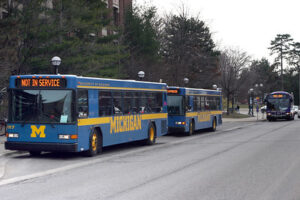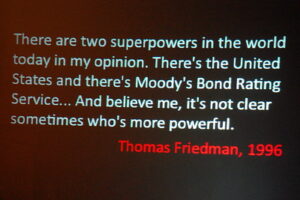At the April 6 Board Retreat, EVP Bill Johnson reported the financial state of the College and provided financial projections for the next three fiscal years. A second presentation provided information regarding tuition rates. A third presentation updated the Administration’s capital expenditure plan. According to Johnson, he provided this information in support of the Administration’s tuition recommendations for the coming fiscal year.
At this time of year, we would be bringing tuition rate recommendations to the Board, and in fact, we are today. And generally, the way that we do that is first provide the Board and update of the financial state of the College, both for the current year and the three-year forecast. And that really provides the Board context as you start to deliberate our recommendations around tuition rates.
Bill Johnson, CFO, Washtenaw Community College
I would like to add some context of my own for the Trustees to consider as they start to deliberate the Administration’s recommendations.
Administration’s tuition recommendations are built on wrong assumptions
First, EVP Johnson lays out some assumptions regarding enrollment for the FY2022 year. In Slide 5 of the first presentation, Johnson states that the revenue assumptions for FY22 include a 6% Fall enrollment decline. It also projects a 4% decline in Winter enrollment. On Slide 7 of the presentation, he predicts a $2.1M increase in tuition revenues and fees.
Second, accepting the premise that Fall enrollment will decline is somewhat dicey. Both the Futures for Frontliners and Michigan Reconnect programs require students to enroll in the 2021 calendar year. Between the two programs, about 180,000 people have applied so far. Even if these programs accept only 60% of applicants, that is still nearly 110,000 new students hitting Michigan’s community colleges this year. WCC should see thousands of them.
Third, to achieve an increase in revenue from tuition and fees while enrollment declines says tuition is going up. On Slide 8, however, Johnson indicates that the Administration’s tuition recommendation holds the cost of in-district tuition and fees constant at $105 per credit hour. Further, he recommends that the out-of-district and out-of-state rates rise by 2% and 4% respectively. I assume the proposed tuition increase will also apply to the out-of-district and out-of-state distance learning programs.
In Slide 14, Johnson shows the current credit-hour breakdown by residency. The slide shows about 124,000 in-district credit hours; 88,000 out-of-district credit hours; about 8,000 out-of-state credit hours and about 4,000 international credit hours.
Students all over care about tuition costs
While the numbers he provides might produce the desired result, he assumes that raising out-of-district and out-of-state tuition rates will fully offset enrollment declines. It is hard to say without knowing how many of the 88,000 out-of-district credit hours come from WCC’s discounted distance learning programs. Johnson bases his out-of-district enrollment assumptions on the “strength of the distance learning programs.” This is the fallacy. If program quality attracts remote learners, it should also attract in-district learners.
But somehow, it does not.
What is attractive about the distance learning programs is their cost, not their quality. WCC offers the distance learning programs to out-of-district and out-of-state students at a nearly 30% discount from out-of-district in-person classes. At the same time, in-district students must pay a premium to enroll in these programs.
The students who enroll in these programs are price sensitive. Raising the cost of these programs, then, makes them less attractive, which will reduce the number of students enrolling in them. Johnson counts on the “quality” of the program to attract out-of-district students, but price alone drives their enrollment. The only way these programs can attract out-of-district students is by deep discounting the cost.
Why are Washtenaw County taxpayers subsidizing out-of-district learning?
That raises a philosophical question. Why are we subsidizing out-of-district students at all? The reason we differentiate between in-district and out-of-district students is to acknowledge the subsidy that in-district residents provide. And Washtenaw County residents provide a very generous subsidy. Giving what amounts to in-district tuition to out-of-district students confers on them a benefit they have not paid for. More importantly, why are we subsidizing just this facet of attendance for out-of-district/out-of-state learners? If WCC is going to subsidize online learning for out-of-district/out-of-state students, it should also subsidize in-person attendance, as it would have the same effect.
Instead of trying to court out-of-district students by giving them a deep discount on out-of-district tuition, why doesn’t the Administration permanently equalize the cost of in-person and online courses for in-district students? Don’t the taxpayers here already pay enough to cover this? Why have we built a resource for non-residents, and more importantly, why doesn’t the tuition WCC charges non-residents more accurately reflect our real cost to serve them?
Photo Credit: bluefield photos bp , via Flickr






















